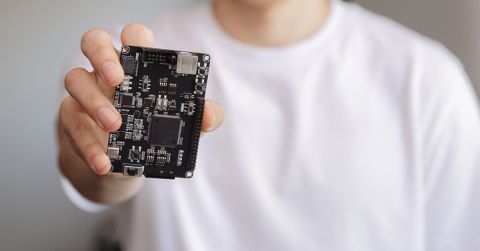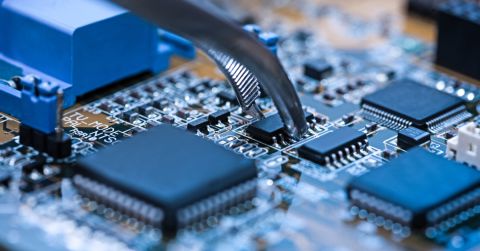Crystals are the Heartbeat in Digital Systems

Crystals emanate frequency that digital systems use to drive the heartbeat for chipsets. The heartbeat in a digital system is the originating frequency that makes command and communication transmission possible. Crystals are made from piezoelectric material which radiate electric charge through mechanical pressure within the material. Mechanical pressure is contained within the crystal lattice of the material. Like an electric field, the electrical charge naturally emanates near-ideal square-wave frequency and is used within embedded systems to drive computation and communication.
Heartbeat is necessary to communicate digital signals. Embedded systems need power and a means of communication to operate. Signals and information ride on pulses generated by clocks. All clocks within the system derive from the packaged crystal and its frequency. Together with the central processing unit, the brain of the system, the heartbeat transmits information that drives system logistics.
 Crystal oscillators provide the heartbeat for your computer’s CPU
Crystal oscillators provide the heartbeat for your computer’s CPU
Packaged Crystals to Programmable Crystal Oscillators
There are three types of packaged crystals in use for today’s embedded systems. Each provide differing levels of functionality suited for today’s applications. Some applications require ability to make several frequencies or to modify frequencies over the life of the application. Others offer programmability to facilitate development with a reference design. Facilitating development allows analysis of jitter contributions from system blocks and their effect on integrity of the heartbeat. Each type of crystal offers characteristics suitable for specific designs.
The first is a packaged crystal that outputs one frequency to a central processing, or other integrated, unit. This is done when the CPU has internal drivers and other circuitry to condition the heartbeat. Circuits within the CPU use phase-locked loops and buffers to divide clock signals and send them to other circuit blocks within the system. This type of packaged crystal is frequently found in consumer electronics.
The second type is a crystal oscillator containing its own circuitry and drivers. Systems frequently require more than one clock for start-up and a crystal oscillator is a good choice. With proper oscillation, rather than the CPU divide and process the heartbeat, the crystal oscillator does this within its block. This type of off-chip clock source allows better management of power supply noise rejection. Eliminating contributing noise from the chipset maintains the clock’s integrity. Clock integrity ensures no loss of bits or no slowdowns of the system.
The third is a programmable crystal oscillator adding I2C protocol to increase functionality of the heartbeat. This is a great option for sophisticated systems needing flexibility during prototyping. Programming allows tuning of the oscillator at any point in design and development. Tuning provides good stability over a wide frequency range. Stability of the oscillator ensures low loss of bits during transmission.
We look at three possible parts for the first type of digital heartbeat today, the packaged crystal.
Parameters to Consider When Selecting a Packaged Crystal
For systems that are using a chipset with internal drivers to produce clock output, a packaged crystal will do. A packaged crystal contains the piece of quartz formed to resonate at a specific frequency. They have one output pin to deliver frequency to the chipset.
BER: Bit error rate. The number of altered bits in a digital transmission per unit time. Bits are altered due to noise, interference, or bit synchronization errors.
Chipset: A set of electronic components in an integrated circuit that manages data flow between the processor, memory, and peripherals.
Frequency: A number of cycles per unit of time.
Jitter: The deviation from true periodicity of a periodic signal.
PLL: Phase-locked loop. A control system that generates an output signal whose phase is related to the phase of the input signal.
Piezoelectricity: The electric charge that accumulates in certain solid materials (such as crystals) in response to mechanical stress.
PPM: Parts per million.
SoC: System on a chip. An integrated circuit that includes all components of a computer or other electronic system. The components typically integrate the central processing unit (CPU), memory, input/output ports, and secondary storage on a single substrate.
Packaged crystals are available in many frequencies from about 3 MHz to 250 MHz. Each vendor allows selection of frequency from a part family. The precise frequency of the crystal to order is accomplished within the part number of the family. The frequency required usually comprises several digits within the overall part number. Vendor datasheets will guide you in selecting the correct part number for the frequency you require.
Abracon, ABLS Series
The Abracon ABLS series of packaged crystals offers frequencies from 3.579545 MHz to 75MHz. Each is stable in frequency over drive level dependency range of less than 10ppm keeping it accurate under wide temperature swings. Packaged crystals are available with varying frequency tolerance and frequency stability. Both frequency tolerance and frequency stability are specified in PPM. Packaged crystals over the frequency range may be ordered with as low as +5ppm and as high as +150ppm. By consulting the datasheet for part selection, as shown below, you may specify your need when ordering.
 Specify required frequency in the part number as shown above
This is found on page 1 of Abracon ABLS HC/49US (AT49) SMD Low Profile Crystal datasheet
Specify required frequency in the part number as shown above
This is found on page 1 of Abracon ABLS HC/49US (AT49) SMD Low Profile Crystal datasheet
This family of packaged crystals is suitable for reflow during assembly. The parts are low in height making them ideal for use within small case parts. Their short, slim profile makes them applicable for consumer electronics and wireless applications. Because of their stability over temperature, they are appropriate for use within automotive and industrial applications as well.
Kyocera, Crystal Units, Surface Mount Type, CX3225GB
The Kyocera CX3225GB family of packaged crystals is available in frequency ranges from 9.8MHz to 54MHz. Each is stable over operating range of -10℃ to 70℃ at 30ppm, and maintains stability during operation with low drift. This family of packaged crystals comes with one range for frequency stability. Evaluating this part during system development would reveal jitter margin while integrated with the chipset.
 This is found on page 1 of Kyocera Crystal Units Surface Mount Type CX3225GB datasheet
This is found on page 1 of Kyocera Crystal Units Surface Mount Type CX3225GB datasheet
This family of packaged crystals are small with low profile. Their package is ceramic and able to assemble using reflow. Because of its small profile and modest temperature stability, this crystal would be suitable for consumer electronics.
Seiko Epson, MHz Range Crystal Unit, FA-128 Series
The Seiko Epson FA-128 series of packaged crystals is available in frequencies from 16MHz to 54MHz. The parts have decent frequency stability at 10ppm. Seiko Epson offers custom orders to provide better tolerances should your application require better stability for both jitter and for temperature stability,
 This is found on page 1 of Seiko Epson MHz Range Crystal Unit FA-128 datasheet
This is found on page 1 of Seiko Epson MHz Range Crystal Unit FA-128 datasheet
This family of parts comes in a small package suitable for use with small consumer, or other, electronics such as mobile phones or other handheld devices. It is compatible with devices operating in the ISM band as well.
Packaged crystals provide the heartbeat for embedded system chipsets. They are the most simple heartbeat available making them suitable for consumer electronics or other systems containing chipsets that contain oscillator drive circuitry within the processor.
Stay up-to-date with our latest articles by signing up for our newsletter.








